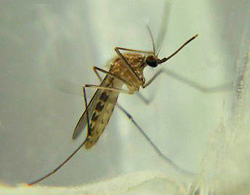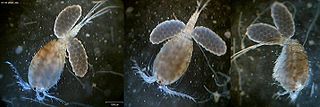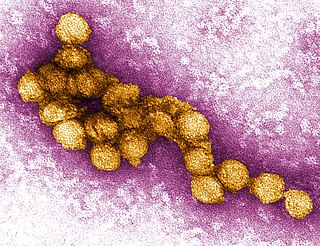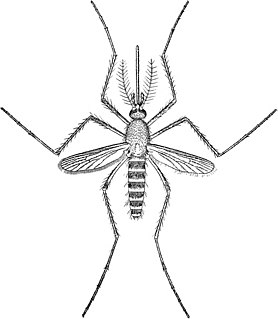
Rift Valley fever (RVF) is a viral disease of humans and livestock that can cause mild to severe symptoms. The mild symptoms may include: fever, muscle pains, and headaches which often last for up to a week. The severe symptoms may include: loss of sight beginning three weeks after the infection, infections of the brain causing severe headaches and confusion, and bleeding together with liver problems which may occur within the first few days. Those who have bleeding have a chance of death as high as 50%.

A mosquito is any member of a group of about 3,500 species of small insects belonging to the order Diptera (flies). Within Diptera, mosquitoes constitute the family Culicidae. The word "mosquito" is Spanish and Portuguese for "little fly". Mosquitoes have a slender segmented body, one pair of wings, one pair of halteres, three pairs of long hair-like legs, and elongated mouthparts.

Culex is a genus of mosquitoes, several species of which serve as vectors of one or more important diseases of birds, humans, and other animals. The diseases they vector include arbovirus infections such as West Nile virus, Japanese encephalitis, or St. Louis encephalitis, but also filariasis and avian malaria. They occur worldwide except for the extreme northern parts of the temperate zone, and are the most common form of mosquito encountered in some major U.S. cities, such as Los Angeles.
Culex (Culex) tritaeniorhynchus is a species of mosquito and is the main vector of the disease Japanese encephalitis. This mosquito is a native of northern Asia, and parts of Africa. Females target large animals for blood extraction, including cattle and swine, and are strongly anthropophilic.

The discipline of medical entomology, or public health entomology, and also veterinary entomology is focused upon insects and arthropods that impact human health. Veterinary entomology is included in this category, because many animal diseases can "jump species" and become a human health threat, for example, bovine encephalitis. Medical entomology also includes scientific research on the behavior, ecology, and epidemiology of arthropod disease vectors, and involves a tremendous outreach to the public, including local and state officials and other stake holders in the interest of public safety. Medical Entomologists are employed by private and public universities, private industries, and federal, state, and local government agencies, including all three branches of the US military - who hire medical entomologists to protect the troops from infectious diseases that can be transmitted by arthropods. Historically, during wars, more people have died due to insect-transmitted diseases, than to all the battle injuries combined.

The London Underground mosquito is a form of mosquito in the genus Culex. It is found in the London Underground railway system as its name suggests, but has a worldwide distribution and long predates the existence of the London Underground. It was first described as a distinct species from Egyptian specimens by the biologist Peter Forsskål (1732–1763). He named this mosquito Culex molestus due to its voracious biting, but later biologists renamed it Culex pipiens f. molestus because there were no morphological differences between it and Culex pipiens. Notably, this mosquito assaulted Londoners sleeping in the Underground during the Blitz, although similar populations were long known.

Culex pipiens, commonly referred to as the common house mosquito, is a species of mosquito. House mosquitoes are some of the most common mosquitoes in the United States. More specifically, Culex pipiens is considered as the northern house mosquito, as it is the most common mosquito to the northern regions of the US. North of the 39th parallel north in the US, only C. pipiens are present, whereas south of the 36th parallel north, only C. quinquefasciatus are present. Additionally, they can be found in both urban and suburban temperate and tropical regions across the world.

Macrocyclops albidus is a larvivorous copepod species.
Plasmodium hermani is a parasite of the genus Plasmodium subgenus Huffia. As in all Plasmodium species, P. hermani has both vertebrate and insect hosts. The vertebrate hosts for this parasite are birds.

Culex quinquefasciatus, commonly known as the southern house mosquito, is a medium-sized mosquito found in tropical and subtropical regions of the world. It is a vector of Wuchereria bancrofti, avian malaria, and arboviruses including St. Louis encephalitis virus, Western equine encephalitis virus, Zika virus and West Nile virus. It is taxonomically regarded as a member of the Culex pipiens species complex. Its genome was sequenced in 2010, and was shown to have 18,883 protein-coding genes.
Culex vishnui is a mosquito belonging to the Culicidae family. It is the most common vector (carrier) of the Japanese encephalitis virus (JEV) in India, Sri Lanka, Thailand, and Sarawak.

West Nile virus (WNV) is a single-stranded RNA virus that causes West Nile fever. It is a member of the family Flaviviridae, specifically from the genus Flavivirus, which also contains the Zika virus, dengue virus, and yellow fever virus. West Nile virus is primarily transmitted by mosquitoes, mostly species of Culex. The primary hosts of WNV are birds, so that the virus remains within a "bird–mosquito–bird" transmission cycle.
Culex (Culex) gelidus is a species of mosquito belonging to the genus Culex. It is found in India, Sri Lanka, Bangladesh, Cambodia, China, Hong Kong, India, Indonesia, Japan, Laos, Malaysia, Myanmar, Nepal, New Guinea (Island); Papua New Guinea, Pakistan, Philippines, Taiwan, Thailand, Vietnam. In 1976, it was identified as a major vector of Japanese encephalitis virus, in India. From an experiment, it was evident that aqueous solution of Calotropis gigantea leaves possess larvicidal activity, mosquito repellent activity and ovicidal activity against Culex gelidus.
Culex elegans is a species of mosquitoes in the subfamily Culicinae. Insectoid.info treats the name as a separated species, whereas Encyclopedia of Life lists it as a synonym for Aedes aegypti. Ian Macdonald described it in 1899 as not associated with malaria.

Culex nigripalpus is a species of medium-sized, dark, blood-feeding mosquito of the family Culicidae.

Culex territans is a species of mosquito in the family Culicidae.
Culex erraticus is a species of mosquito in the family Culicidae.
Mesocyclops longisetus is a species of freshwater copepod in the family Cyclopidae. Two subspecies are accepted, Mesocyclops longisetus curvatus Dussart, 1987, and Mesocyclops longisetus longisetus. It has a neotropical distribution.

Culex torrentium is a species of mosquito in the family Culicidae. This species has a wide distribution in the temperate Palaearctic region.













